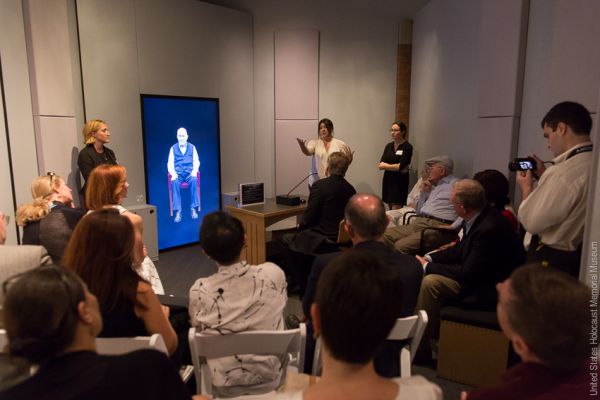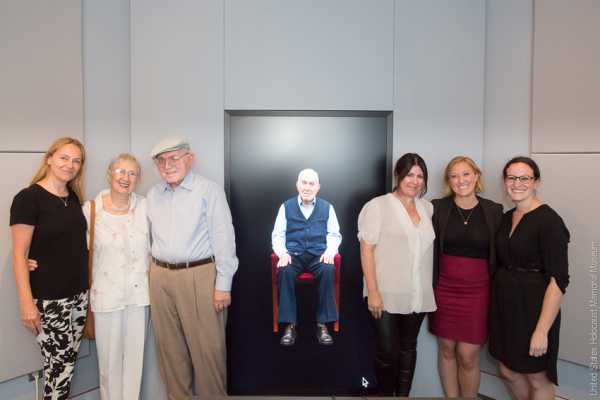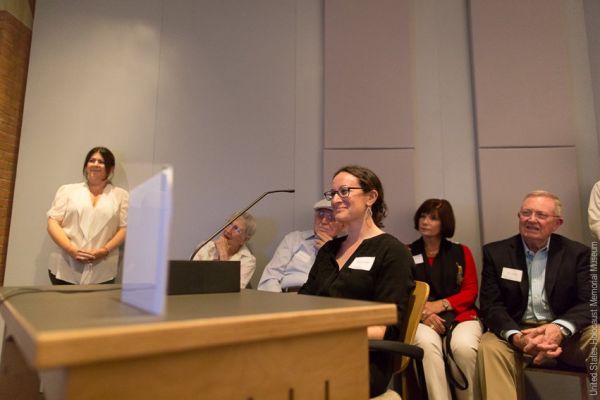A Lesson in Technology and Humanity

For six months this spring and summer, I had the pleasure of leading a team of staff and volunteers facilitating the beta run of New Dimensions in Testimony (NDT) from USC Shoah Foundation at the United States Holocaust Memorial Museum in Washington, DC. I watched people of all ages approach the giant monitor displaying an image of Holocaust survivor Pinchas Gutter, first with trepidation, then curiosity, then, at last, affection. Here are a few things that I learned about technology and humanity from the project.
Listening can be just as powerful as asking questions.
During the run of the project at the Holocaust Museum, we invited visitors to drop into the space, rather than working with scheduled, organized groups. Sometimes small family groups would come in, other times school groups would spend time with us, and frequently individuals would arrive on their own. When groups arrived together, often questions for Pinchas would be filtered through the first brave person who took the initiative to approach the microphone, while the rest of the group stood back and listened. We also observed a number of individuals who didn’t ask a question at all, but instead chose to sit back and listen to the answers to other visitors’ questions.

New Dimensions in Testimony is the right technology at the right time.
A number of people who came to the space where we displayed the system arrived in search of the “Holocaust survivor hologram.” Which it wasn’t: we displayed Pinchas on a 70” 2D flat monitor. Fortunately, not having a hologram is exactly the right technology right now. Today, the ubiquity of talking on Skype or Facetime means that the idea of asking questions of a face displayed on a flat screen, and having them answered in real time, is pretty natural for a number of our visitors. This meant that the technology faded into the background: rather than focusing on “whoa, this technology is so cool and futuristic!” our visitors were able to focus on learning from Pinchas’ testimony. As 3D and hologram technology become more widely used, displaying New Dimensions in Testimony in the technological medium of the day will keep it feeling fresh, but until then, meeting our participants exactly where they are, with technology they know, is the perfect place to be.

Be open to many different kinds of enthusiasm.
One addition to New Dimensions in Testimony that I’d love to see accompany the system as it moves forward is an introduction and eye-catch. At the Holocaust Museum, staff and volunteers were responsible for recruiting visitors into the space set aside for the installation, and thus for explaining what it was. I watched for the “wide-eyed moment”: the point at which visitors went from “ok, this is a little weird” to “whoa! I need to participate in this right now.” Sometimes, simply saying “Would you like to interact with the video testimony of a Holocaust survivor?” was enough. For other visitors, mentioning that Pinchas had recorded 2,000 answers over 5 days of filming was the jaw-dropper. Still others were mesmerized by the speech recognition system. As a tech nerd and history buff, I was equally excited to share every part of the experience with our visitors. I saw as well that the visitors who were jazzed about the technological aspects would enter the room to witness how the system worked, but would stay to hear more of the content.
Going forward, with this and any other public experience, we need to ensure that each of our institutions is also just as enthusiastic about the many facets of our projects, because we never know what will catch someone’s heart. In all things, we need to ensure we meet our visitors where they are, rather than only being open to those people who meet our preconceived notions about what is interesting.
Running the Holocaust Museum’s pilot of New Dimensions in Testimony, training our 50 facilitators, and learning with and from our visitors as they interacted with Pinchas’ testimony is one of the highlights of my career thus far. I look forward to seeing where USC Shoah Foundation takes it next!